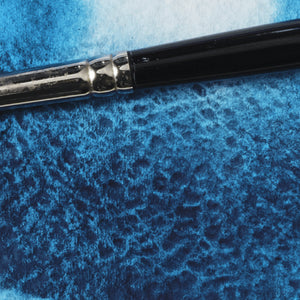0:08: Hello, this Masterclass will show you how to make a cyanotype using watercolour paper, which we will hand-finish with watercolours.
0:14: Making cyanotypes is a way of producing cyan-blue prints using the chemicals ferric ammonium citrate and potassium ferricyanide. Although it is a simple process, the results are varied and exciting.
0:27: I'm filling these two bottles with filtered water. The ones I'm using are labelled cyanotype bottles A and B, but you can also buy the powders separately and mix in your own light tight bottles. I now have to give them a good shake and leave them overnight. The next day measure equal parts of the two liquids into a mixing pot. Mix these together well - I'm doing this with a brush. This is being filmed in bright lights to demonstrate, but you should do this in subdued lighting. It doesn't have to be pitch black just dim. Only mix the two chemicals when you are ready to apply them to your surface because it should be used within an hour or two of mixing. Still in subdued lighting, coat Winsor & Newton Watercolour Paper in the chemical mixture using a watercolour brush. I'm using a 640gsm rough watercolour paper. This is a perfect surface for cyanotypes because this weight will easily withstand being in a water bath for a few minutes. I'm going to leave this to dry in a dark place for approximately one hour. You can leave it for longer or until you are ready for the next steps.
1:45: Now it's time to prepare what you would like to use to create a two-tone image. I have chosen to use string as it should give a pleasing image, rather like an abstract line drawing. I kept this paper in a light tight folder, and this next part should be done quickly or in a low light space. I'm arranging the string into a composition on top of the prepared paper. Since I am going to put this outside, I will lay a sheet of perspex on top to stop the string from blowing away and keep it flat on the paper. It can now be put in direct sunlight outside. If it's sunny it can be exposed for as little as one minute but if the UV levels are low, it's best to leave it for two hours or so. The colour should shift and there should be a contract between the exposed and unexposed areas of the paper.
2:25: Now it's time to develop the image. I'm going to allow the water in the tray to wash over the print for about 3 minutes. I've used filtered water as I am in a hard water area, otherwise tap water is fine. The colours will change straight away in the water. This watercolour paper is great as it won't cockle in the water and is perfectly happy being washed for several minutes. Remove the water and allow to dry. The full contrast will happen after 24 hours so leave to dry overnight.
2:57: This is one I made yesterday. The Cyan Blue is a lovely deep colour, and the string has left an interesting drawing in white within the print. The paper has given a satisfying texture that looks somewhere between a watercolour painting and a photogram. I'm going to finish this by adding a little bit of colour to the cyanotype. Here are three of Winsor & Newton's Cadmium-Free Watercolours: Lemon, Orange and Red. I'm going to tint the white areas where the string was, starting by applying just water to the paper and then I will add watercolour. Working this way, applying watercolour to an area of wet paper, gives a bit more control to the colour application, which is what I want here. This works really nicely to give a 3D effect to certain shapes or can be a way of giving an effect similar to a hand-tinted photograph.












![WN PWC KAREN KLUGLEIN BOTANICAL SET [FRONT]](http://www.winsornewton.com/cdn/shop/files/136444.jpg?crop=center&v=1740654068&width=20)
![WN PWC KAREN KLUGLEIN BOTANICAL SET [OPEN 2]](http://www.winsornewton.com/cdn/shop/files/136447.jpg?crop=center&v=1740654068&width=20)
![WN PWC ESSENTIAL SET [FRONT]](http://www.winsornewton.com/cdn/shop/files/137583.jpg?crop=center&v=1740762356&width=20)
![WN PWC ESSENTIAL SET [OPEN]](http://www.winsornewton.com/cdn/shop/files/137581.jpg?crop=center&v=1740762356&width=20)
![W&N GALERIA CARDBOARD SET 10X12ML [B014096] 884955097809 [FOP]](http://www.winsornewton.com/cdn/shop/files/138855.jpg?crop=center&v=1740761853&width=20)
![W&N GALERIA CARDBOARD SET 10X12ML 884955097809 [OPEN]](http://www.winsornewton.com/cdn/shop/files/138856.jpg?crop=center&v=1740761853&width=20)

![W&N PROMARKER 24PC STUDENT DESIGNER 884955043295 [FRONT]](http://www.winsornewton.com/cdn/shop/files/78674_d4d78a69-7150-4bf4-a504-3cb5304b0f80.jpg?crop=center&v=1721326116&width=20)

![W&N PROFESSIONAL WATER COLOUR TYRIAN PURPLE [SWATCH]](http://www.winsornewton.com/cdn/shop/files/136113.jpg?crop=center&v=1724423390&width=20)
![W&N WINTON OIL COLOUR [COMPOSITE] 37ML TITANIUM WHITE 094376711653](http://www.winsornewton.com/cdn/shop/files/9238_5073745e-fcfe-4fad-aab4-d631b84e4491.jpg?crop=center&v=1721326117&width=20)
![W&N WINTON OIL COLOUR [SPLODGE] TITANIUM WHITE](http://www.winsornewton.com/cdn/shop/files/131754_19b392ee-9bf6-4caf-a2eb-0356ec1c660a.jpg?crop=center&v=1721326118&width=20)